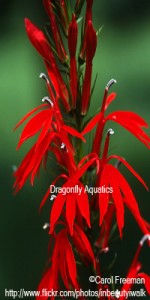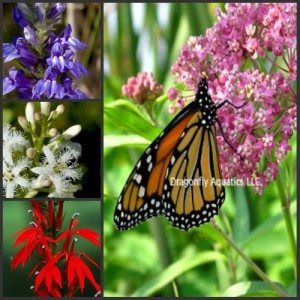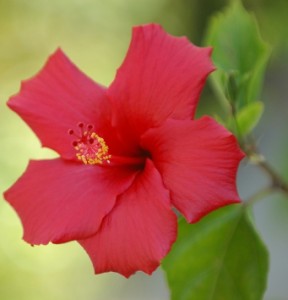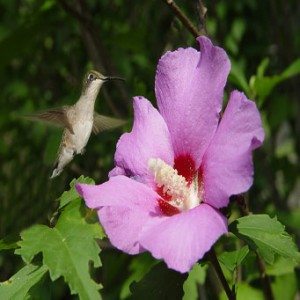I'm not certain of the identity of this butterfly. I thought perhaps it was a male Eastern Tiger Swallowtail. I'm really not certain, although it sure liked my dwarf crab-apple tree. It came back day after day.....I'm thinking it was the same one.
I know we don't want to think about it but it won't be long and fall will be here and we all know what comes next.....its time for us to be thinking about taking the extra care with our pond plants to make them comfortable for the winter cold. I've noticed the butterflies aren't as plentiful as they had been but occassionally I'm able to catch one.
HARDY BOG/MARGINAL PLANTS
Once your hardy marginal plants begin to brown, usually after the first hard frost, prune back excess foliage and discard any decaying material, so it does not compromise the water quality over the winter months. Potted bog plants such as Pickeral, Thalia Dealbata, and Japanese Variegated Iris should be placed at a sufficient depth to avoid freezing the crown of the plant. Most of the other hardy bog plants can be left as they are and will return the following spring.
Tropical Bog Plants
Many of the tropical bog plants will winter well indoors in a sunny window or with a grow light. They do not need to be submerged in water. Keep the soil constantly moist by placing the potted plants in a tray of water.
 I thought I'd publish this article we wrote last year again. When trying to get some of the bog plants started in your ponds its best to start them out slowly in the water, since most of them are swamp like plants. They can tolerate a few inches above their pot once they are established and growing. When growing them in our greenhouses we have them growing in two inch net pots in bins that have about one inch of water in them so the water is keeping their roots wet.
I thought I'd publish this article we wrote last year again. When trying to get some of the bog plants started in your ponds its best to start them out slowly in the water, since most of them are swamp like plants. They can tolerate a few inches above their pot once they are established and growing. When growing them in our greenhouses we have them growing in two inch net pots in bins that have about one inch of water in them so the water is keeping their roots wet.
Here's the article.
I've been wanting to write something on this subject for some time now. Finally, I have a bit of time to address the subject of water depth for bog plants and marginal plants. Simply put, bog plants like their "feet" wet. Translation....roots and soil moist at all times. When the plants are first planted, this is especially important. Many of the bog plants will take deeper water as they mature and spread. But, when you first receive your bog plants, you will have better success if you place them where there is no more than a half inch or less of water above the soil line. Think of the marshes and swampy areas, you have passed while traveling down the road. These natural reservoirs, fill during the rainy season and will dry out during dry spells. The plants adjust to the varying water depth and grow and spread rapidly. If you have a question on a particular plant, just ask and we will be happy to help you plant and grow beautiful marginal and bog plants.
 I've been wanting to write something on this subject for some time now. Finally, I have a bit of time to address the subject of water depth for bog plants and marginal plants. Simply put, bog plants like their "feet" wet. Translation....roots and soil moist at all times. When the plants are first planted, this is especially important. Many of the bog plants will take deeper water as they mature and spread. But, when you first receive your bog plants, you will have better success if you place them where there is no more than a half inch or less of water above the soil line. Think of the marshes and swampy areas, you have passed while traveling down the road. These natural reservoirs, fill during the rainy season and will dry out during dry spells. The plants adjust to the varying water depth and grow and spread rapidly. If you have a question on a particular plant, just ask and we will be happy to help you plant and grow beautiful marginal and bog plants.
I've been wanting to write something on this subject for some time now. Finally, I have a bit of time to address the subject of water depth for bog plants and marginal plants. Simply put, bog plants like their "feet" wet. Translation....roots and soil moist at all times. When the plants are first planted, this is especially important. Many of the bog plants will take deeper water as they mature and spread. But, when you first receive your bog plants, you will have better success if you place them where there is no more than a half inch or less of water above the soil line. Think of the marshes and swampy areas, you have passed while traveling down the road. These natural reservoirs, fill during the rainy season and will dry out during dry spells. The plants adjust to the varying water depth and grow and spread rapidly. If you have a question on a particular plant, just ask and we will be happy to help you plant and grow beautiful marginal and bog plants.
 Red Water Hibiscus (Hibiscus coccineas) is only hardy in Zones 7-11. It has deep crimson flowers that are 5 - 8 inches wide. It is among the reddest of hibiscus in the plant kingdom. Not only are the flowers magnificant but the leaves are narrow and divided, much like that of a Japanese maple leaf. A truly striking plant.
Red Water Hibiscus (Hibiscus coccineas) is only hardy in Zones 7-11. It has deep crimson flowers that are 5 - 8 inches wide. It is among the reddest of hibiscus in the plant kingdom. Not only are the flowers magnificant but the leaves are narrow and divided, much like that of a Japanese maple leaf. A truly striking plant.
This hibiscus will grow 6 - 9 feet high and 3 - 6 feet wide. Plant it in sun to part shade but it prefers sun. It needs moist soil or water to 4 inches deep. You can winter it over by bringing it indoors or covering it with heavy mulch.
This is another bog plant that is a favorite of the hummingbirds and butterflies.
 Water hibiscus (Hibiscus moscheutos) sometimes called swamp mallow or swamp rose mallow is a medium size shrub that has stunning 10-12 inch flowers. They range in colors from white to deep red. This hibiscus is hardy to Zone 5 and up. This hibiscus prefers moist soil or water up to 4 inches deep but will tolerate even dry soil. Plant in sun to part shade. Its average height ranges from 24 inches to 36 inches and will spread 2 - 4 feet.
Water hibiscus (Hibiscus moscheutos) sometimes called swamp mallow or swamp rose mallow is a medium size shrub that has stunning 10-12 inch flowers. They range in colors from white to deep red. This hibiscus is hardy to Zone 5 and up. This hibiscus prefers moist soil or water up to 4 inches deep but will tolerate even dry soil. Plant in sun to part shade. Its average height ranges from 24 inches to 36 inches and will spread 2 - 4 feet.
This is a very easy bog plant to grow and performs well needing little care. Its the perfect bog plant for along your pond, stream or bog area. You'll be amazed at the butterflies and hummingbirds that are attracted to this plant.
When wintering over cut back the stems. This plant can be propagated by division.
Buy Water Hibiscus, Pink Water Hibiscus, White Water Hibiscus here.
 Hummingbirds are primarily attracted to bright colors such as, red, orange and dark purple colors. Tubular shaped flowers are among their favorites because of the amount of nectar they can hold. While flower clusters also attract them, they don't hold as much nectar and the hummingbird has to make more trips expending more energy to consume enough nectar. They also feed on small spiders and tiny insects found amongst your flowers.
Hummingbirds are primarily attracted to bright colors such as, red, orange and dark purple colors. Tubular shaped flowers are among their favorites because of the amount of nectar they can hold. While flower clusters also attract them, they don't hold as much nectar and the hummingbird has to make more trips expending more energy to consume enough nectar. They also feed on small spiders and tiny insects found amongst your flowers.
You may want to plant smaller trees around your pond to give them a place to perch. They like the smaller branches, twigs or leaf stems to sit on and rest. The trees that attract them are your lilacs, rose of Sharon, hawthorn, redbud and weigela.
Among the pond plants that they seemed attracted to the most are the butterfly plant, hibiscus, lobelia, obedient flower and cardinal flower. If you have an area around your water garden to plant other ground plants this will also attract them to your pond. Such plants as foxglove, mandevillas, petunias, hollyhock, columbine and lupine are a few favorites of the hummingbird. I found by planting impatiens and hibiscus in my bog area creates a nice look and gives the hummingbirds a place to enjoy.
Not only will you be attracting hummingbirds to your pond area but butterflies enjoy alot of the same plants. Where your hummingbirds are attracted to the nectar by sight, the butterflies are attracted to them by the smell.
Enjoy every aspect of nature by creating that area where you'll not only enjoy the peacefulness of your water garden but the magnificent hummingbirds as well.
Buy obedient flower,cardinal flower,lobelia here.